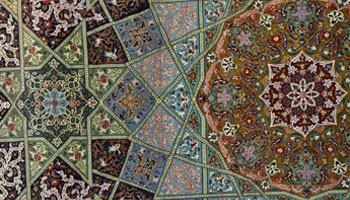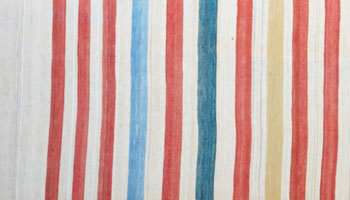History of Rugs
Oriental Rugs for a Lifetime and Generations
For over 2,500 years, oriental rugs have been used in the East by nomads and villagers for warmth and beauty. More recently in the West, they have graced homes with their art and luxury, and go with any dcor. An Oriental rug is a purchase for a lifetime and when properly maintained, for generations. The information contained here offers simple, basic advice for the protection and care of your investment.
The Wonders of Wool
Oriental rugs are generally made of wool and are easily and economically maintained. Rugs of wool are extremely durable and consistently out-perform other materials. Unlike other fibers, wool is much more resilient, cleans better, and stays clean longer.
Design
Distinct types of patterns and designs have developed in various districts. By identifying the pattern of the field one can distinguish among four basic types:
- Medallion design
- All-over or repeat
- Representational
- Niche and tree
Medallion, the first group, is designed with its field in a solid color or with small designs surrounding a central medallion.
Repeat, the second group, with its dense repeating pattern cut off by the borders, usually has a more geometric pattern.
Representational, the third major group depicts people and animals, often in story situations.
Niche and tree, the last group is uniform from the point of view of style even though the patterns vary considerably.
Weaver
Carpets today are woven the same way they were thousands of years ago. People who say that carpets must be produced by mechanical means are speaking out of ignorance; presumably they cannot imagine that so even a carpet can be produced by hand.
Rows of knots are tied on a foundation of warp and weft and become the pile. The warp runs along the length of the carpet and the fineness of the weave depends on its thickness and the proximity of the warps to one another.
When the rug is completed the ends form fringes which may be braided, tassled or secured in some such manner. The wefts pass under and over the warps from one side of the rug to the other. They are sometimes unpiled to allow them to be tightly packed to secure each row of knots.
The weaver’s instruments are simple and hand made. The yarn is cut off with a knife after the knot has been made. The weft and rows of knots are then packed together with a heavy iron comb-beter with handle. The newly woven part is smoothed with a strong steel comb before it is trimmed roughly while it is still in the loom. After the carpet has been removed from the loom it is given a final trim with shears and a razor like tool.
There are two basic knots: the Turkish (Ghiordes knot) and the Persian (Sehna knot).
Dyes
There are three basic categories of dye:
- Natural dyes
- Aniline dyes
- Chrome dyes
Natural dyes are made from flowers, roots, berries, bark, insects and occasionally from minerals or metals such as iron. The dyer is highly respected for his skill and deserves credit for the beauty, clarity and depth of colors in an Oriental rug.
Aniline dyes are acid-based synthetics. Such dyes are harsh; they strip essential oils from the wool making it stiff, hard and brittle. Aniline dyes are used with poorer grades of wool and lower quality rugs.
Chromium dyes have been developed over the last 40 years. In quality they are now almost equal to vegetable dyes. They are colorfast in washing, they do not harm the wool and they offer the rug designer a much wider variety of shades and colors than natural dyes. Most rugs today combine the use of natural and chromium dyes.
Materials
The materials in an Oriental rug are chiefly wool or silk knotted onto a cotton foundation. Wool is a critical element in the quality of an Oriental rug.
Wool for rugs is classified into three categories:
- Live wool
- Dead wool
- Used wool
Live wool is wool sheared from living sheep. Dead wool is removed from sheep’s hides chemically. Used wool is recycled from old cloth, redyed and used in low grade rugs.Good, live wool is durable, and soft; it retains its lanolin and essential oils giving the rug resilience. Good wool captures the light and diffuses it among its fibers.
Dead wool is taken from slaughtered animals by chemicals and is dry, brittle and abrasive. The colors are cloudy; light is reflected off the surface of the wool. Such rugs do not wear well and have no resilience.
Intensive use of a good wool carpet over the course of time gradually polishes the wool and the natural oils come to the surface lending a wonderful sheen. In fact, an older rug sometimes looks as though it is made of silk instead of wool.
Color
Oriental tradition attributes a specific meaning to each color. These meanings are an integral part of the Easterner’s beliefs about life and order in the universe. Tonality, shading, placement and arrangement of color are other important factors








